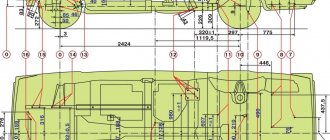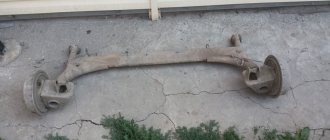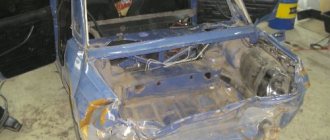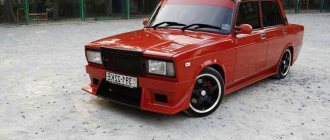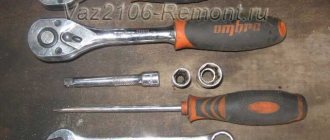How much does the VAZ weigh?
Perhaps one of the most popular cars in the post-Soviet space was, is and remains the VAZ.
This car has captivated many generations. However, how did it all begin? When was the first VAZ car produced and how much did it weigh? You will learn the answers to these and other questions from this article. The first VAZ car was produced by the Volzhsky Automobile Plant on April 19, 1970. The make of this car was VAZ-2101 Zhiguli. Its production was carried out according to the analogue of the Fiat concern. Moreover, VAZ owes its appearance to this particular brand of Fiat 124, produced in 1966. Here, in fact, is it:
As a result of some design improvements, the first domestic car, the VAZ 2101 of 1970, was produced:
The weight of this car was 955 kg. Moreover, of this mass the engine weighed 114 kg.
It has not lost its popularity to this day. In 2000, it was recognized as the best car among eighty thousand car enthusiasts surveyed in the CIS countries and Russia. It was named the best car of the century, VAZ 2101. At the time of its production, it was considered the most comfortable, reliable and modern domestic car. Its presence was a sign of wealth and prosperity!
But the Volzhsky Automobile Plant did not stop there. He created entire collections of this car. Each of them differed in its configuration, as well as its total weight. Therefore, now we will compare some VAZ models by their weight.
- VAZ 2102 has a weight of 1010 kg .
- VAZ 2103 has a weight of 965 kg .
- VAZ 2104 has a weight of 1020 kg .
- VAZ 2105 has a weight of 1060 kg .
- VAZ 2106 has a weight of 1045 kg .
- VAZ 2107 weighs 1049 kg .
- VAZ 2108 weighs 945 kg .
- VAZ 2109 weighs 915 kg .
- VAZ 2110 has a weight of 1020 kg .
- VAZ 2111 has a weight of 1055 kg .
- VAZ 2112 has a weight of 1060 kg .
- VAZ 2113 weighs 975 kg .
- VAZ 2114 weighs 985 kg .
- VAZ 2115 has a weight of 1000 kg .
- VAZ 2116 weighs 1276 kg .
- VAZ 2117 has a weight of 1110 kg .
- VAZ 2118 has a weight of 1110 kg .
- VAZ 2119 has a weight of 1110 kg .
- VAZ 2120 has a weight of 1110 kg .
- VAZ 2121 has a weight of 1550 kg .
- VAZ 2122 has a weight of 1122 kg .
- VAZ 2123 has a weight of 1300 kg .
But this is the total weight of a VAZ car. As for some parts of the car, the weight of, for example, a VAZ 2106 can be decomposed as follows:
- The weight of the engine with equipment is 140 kilograms .
- The weight of the gearbox is 26 kilograms .
- The weight of the square shaft is 10 kilograms .
- The weight of the rear axle is 52 kilograms .
- Radiator weight – 7 kilograms .
- Body weight – 280 kilograms .
On average, the weight of all components of a VAZ car has approximately the same mass. Throughout the entire period of existence of this car, quite interesting facts have been recorded that simply cannot be ignored. It’s hard to imagine that a car weighing an average of 1 ton is very popular.
So, the VAZ 2121 Niva car is not only the most popular throughout the USSR, but also the most exported. Just imagine, this model was produced in 1.8 million cars. And of this amount, 500,000 were sold to more than 100 countries. As we remember, the weight of the VAZ 2121 is 1550 kilograms . This means that over the entire period, 775,000,000 kilograms of this car were sold! Also, this particular model of all Soviet cars was driven in Japan. As for the design of the VAZ 2108, it was developed by the currently well-known company Porshe. Its engine weighs 127.3 kilograms . This became necessary due to the fact that the demand for this brand of car was greatly reduced. For this reason, they decided to modernize it.
Moreover, the VAZ car became more popular because the Lada car was the first car of the famous Formula 1 racer - Kimi Raikkonen. His father loved this car extremely much for its reliability.
So, we learned that each VAZ car model has its own separate weight. But throughout the history of its existence and production, it has not undergone major changes.
Replies@Mail.Ru: Lada is a Lada?
Previously it was called Zhiguli, now Lada. Zhiguli should be associated with 01 to 07. Everything further from 08 is already Lada.
It’s like that’s what they call Lada cars now... you can just call them basins...
Both Lada and Zhiguli are trademarks owned by AvtoVAZ OJSC.
Lada is a Lada after 2108 or 2106. I don’t remember exactly
Yes Yes! Lada is one of the Lada models
no market. of course it’s just an old name, now according to the model they say seven or prior
Lada car name is VAZ, Zhiguli is the old name
yes, all right zhugliki!
Lada is the name of the car for export Zhigugi in European does not sound very euphonious….
Zhiguli are models of VAZ cars, starting with VAZ-2101 and up to VAZ-2107, the rest are Lada...
Lada to six after vases and after Lada
This is a Nissan Laurel :-)
in the early eighties they began to call it LADA, before that ZHIGULI.
VAZ is: OKA, LADA, ZHIGULI, NIVA.
yes it's all the same
horseradish is not sweeter than radish!
touch.otvet.mail.ru
Technical characteristics, dimensions and parameters of the VAZ 2107
This is a reminder for drivers of the VAZ 2107 (also relevant for other classics), I decided to create it because minor technical questions often arise, and it takes a lot of time to find the answer. And here everything is in one place.
So, VAZ 2107 technical characteristics, dimensions, parameters.
VAZ 2107
was
produced from March 1982 to April 2012.
In Egypt it has been produced since 2006 to this day.
It has a 5-seater sedan-type body, in-line 4-cylinder gasoline engines, paired with a 4 or 5-speed manual transmission. It is included in the class of subcompact cars, according to the European classification - class “B”. And not C, as they say on the forums. C class is Ford Focus, KIA Ceed, etc. Wheel formula 4x2, rear wheel drive. The progenitor is the Italian Fiat 124. General parameters of the VAZ 2107
Length
— 4145 mm
Width
— 1620 mm
Height
— 1446 mm
Base
— 2424 mm
Front wheel track
1365
Rear wheel track
— 1321 mm
Ground clearance
— to the front suspension cross member — 159 mm, to the rear axle beam — 154, to the body muffler - 120 mm.
Not bad, for example in the Opel Zafira, only 150 mm to the highest point. Load capacity
- 400 kg
Trunk volume
- 385 liters
Curb weight
- 1060 kg
Gross weight
- 1460 kg
Towed trailer weight
, without brakes - 300 kg, with brakes - 600 kg.
VAZ 2107 engines
The VAZ 2107 was equipped with several engines (for Russia and the USSR), these are:
VAZ 2103 engine (8 class, 1500 cm3, 71 hp, carburetor) VAZ 2105 engine (8 class, 1300 cm3, 64 hp, carburetor, timing belt drive) VAZ 2106 engine ( 8 class, 1600 cm3, 79 hp, carburetor) VAZ 2104 engine (8 class, 1500 cm5, 68 hp, central injection) VAZ 21067 engine (8 class, 1600 cm3, 74 hp, distributed injection) RPD engine (rotary, 1300 cm3, 140 hp)
Piston diameter and stroke:
- for 1300 = 79 mm x 66 mm - for 1500 = 76 mm x 80 mm - for 1600 = 79 mm x 80 mm - for 1700 = 82 mm x 80 mm
Compression ratio for all engines - 8.5 Cylinder operating order: 1-3-4-2
For carburetor VAZ 2107, DAAZ 2107-1107010 carburetors and their modifications were used. A-92 gasoline is used as fuel.
The injector for Euro-3 standards is already designed for A-95 gasoline. Spark plugs for VAZ 2107:
— for carburetor engines
— A17DVR or A17DV-10;
- for injector
- A17DVRM.
Oil for VAZ 2107:
For all classic engines, the optimal choice is semi-synthetic 5W40. If your region has severe frosts, and most of the time it is below minus 30, then choose 0W40. If your frosts are not severe and the summer is hot, then the oil is better than 10W40.
Change of oil
It is produced once every 10,000 km
VAZ 2107 body
All-metal, load-bearing, with 4 doors. Body rigidity - 7200 Nm/deg.
The width of the VAZ 2107 interior, and all classics in general (from the rear door trims at the seat level) is 1250 mm. Between the central pillars of the cabin, at a level of 80 cm from the floor - 1234 mm.
The length of the front door opening of the VAZ 2107 (and all classics) is 889 mm, the rear door is 819 mm.
Electrical equipment VAZ 2107
Wiring type:
single-wire, minus on the car body (ground).
Accumulator battery:
6ST-55, capacity 55 Ah. Batteries with a capacity of 60 and 65 Amperes are also suitable, but you need to check the dimensions. Typically it is 242mm x 175mm x 192mm.
Operating voltage:
13.6 -14.6 volts.
The generator (G221)
must deliver a current of no more than 1/10 of the battery capacity, i.e. approximately 2 to 5.5 Amps.
Ignition coil
— B117 or B117-A (for carburetor engines) Starter — ST221
— low and high beam lamp: H4 or AKP2-60+55 (in Russian) — side marker lamp and side turn signals: T4W or A12-4-1 — turn signal lamp in the headlight, fog lights, reverse and brake lights: P21W or A12-21-3 - license plate and interior lighting lamp: C5W or AC12-5-1 Refueling tanks
Engines
| Options | VAZ 2103 | VAZ 2106 | VAZ 2104 | VAZ 21067 |
| Number and arrangement of cylinders | four-cylinder, four-stroke, in-line | |||
| Supply system | carburetor | distributed injection | ||
| Octane number of gasoline | 92-93 | 95 | ||
| Cylinder diameter and piston stroke, mm | 76×80 | 79×80 | 76×80 | 79×80 |
| Cylinder operating order | 1-3-4-2 | |||
| Compression ratio | 8,5 | 8,5 | 8,5 | 8,5 |
| Working volume, l | 1,45 | 1,57 | 1,45 | 1,57 |
| Rated power, according to GOST 14846 (net), kW (hp) | 52,5 (71,4) | 54,8 (74,5) | 50,0 (68,0) | 54,5 |
| Crankshaft rotation speed at rated power, min-1 | 5600 | 5600 | 5000 | 5000 |
| Maximum torque at crankshaft speed 3400 min-1 (3000 min-1 for VAZ 2106 engine), N*m | 103,9 | 116 | — | — |
| Minimum crankshaft rotation speed, min-1 | 850-900 | 850-900 | 820-880 | 820-880 |
| Direction of rotation of the crankshaft from the pulley side | right | |||
| Lubrication system | combined, pressure and spray | |||
| Cooling system | liquid, closed, forced circulation | |||
| Crankcase ventilation system | forced, with crankcase gases vented into the intake manifold | |||
How much does a VAZ 2107 weigh in full?
A car's directional stability and handling are also directly related to its weight. The peak of popularity of large, heavy cars abroad occurred in the 50-60s of the last century. Then the auto industry produced truly gigantic cars. For example, the Cadillac Eldorado modification 8.2 weighed almost 3 tons. Agree that for such a weight, an appropriate makeweight is needed.
But as time passed, it became clear that in order to further develop and improve the most important characteristics of the car, it was necessary to resort to reducing its overall weight. And if we compare the middle of the last century and today, cars have lost half, or even more, of their own weight. Plastic, carbon fiber reinforced plastic, light metals - all these innovations have made it possible to make the weight of a passenger car significantly lower.
Of course, for lovers of everything big and heavy, cars are produced that look like steamships that drink buckets of gasoline, but this is rather an exception to the rule.
How “Zhiguli” became “Lada” - Avtotsentr.ua
Why are some VAZ cars called “Zhiguli”, while others are called “Lada”? My grandfather says that Lada is a “luxury” modification of VAZ. Who came up with these names and what is encrypted in the logo?
When construction of a new plant for the production of small passenger cars began in the Soviet Union in 1966, it turned out that coming up with a name for it was almost as difficult as building workshops.
If you give the company a name by analogy with other allied auto giants (GAZ, KrAZ, MAZ), the abbreviation will turn out to be dissonant. This question, not the most important at that time, remained open, and the enterprise under construction in official documents was called “Plant for the production of passenger cars in Togliatti.” The current name of the auto giant was involuntarily suggested by employees of the Fiat company, with whose technical assistance the Soviet construction was underway. To shorten the above phrase, the Italians began to write “Plant on the Volga” in their specifications. Tolyatti veterans recall that after this, from the beginning of 1967, the name “Volzhsky Automobile Plant” - VAZ - took root.
And the whole country came up with a name for the car. An all-Union competition was announced, the results of which were summed up on November 1, 1968. Among the ten thousand proposed names, there were also some that were not entirely appropriate: “Carnation”, “Argamak”, etc. One hundred options made it to the “finals”. And the godfather of the mass Soviet small car, they say, was the then secretary of the regional party committee, who approved the name “Zhiguli” for the VAZ-2101 and other “classic” models - after the name of the mountainous area near Tolyatti.
“Geographical” names were often given to products of the Soviet automobile industry, but soon the overlay “surfaced” with the “Zhiguli”. When they began to prepare export deliveries of the VAZ-2101, it turned out that in some European languages there is a very similar-sounding word “gigolo”, which was used to describe a young man leading an antisocial lifestyle. Then the foreign economic relations department of VAZ came up with a foreign name for the Zhiguli - Lada. This native Russian word means “beloved”, is simply spelled and sounds good in all languages. This name became a foreign nickname for “Zhiguli”, and with the updating of the model range it began to be used in the domestic market. Since last year, all VAZ cars are called “Lada”.
Together with the VAZ-2101, the trademark of Togliatti cars was born: a boat under sail, made in the form of the letter B - the capital letter of the name of the plant. Since then, the emblem on Lad radiators has been modified several times, but the stylized boat on the Volga surface has always been preserved.
Igor Shirokun Photo by Sergey Kuzmich and AvtoVAZ
www.autocentre.ua
Weight of passenger cars in tabular format
We present to your attention a table that shows the weight of the car by brand.
| car model | Curb weight |
| Weight of the Oka 1111 car, weight of the Okushka | 635 kg |
| Weight of the car Oka 1113 | 645 kg |
| Weight of a VAZ 2101 car, weight of a penny | 955 kg |
| Weight of the VAZ 2102 car | 1010 kg |
| Weight of the VAZ 2103 car | 965 kg |
| Weight of the car VAZ 2104, weight of tens 2110 | 1020 kg |
| The weight of the VAZ 2105 car, the weight of the five | 1060 kg |
| Weight of the VAZ 2106 car, weight of the six | 1045 kg |
| Weight of the VAZ 2107 car, weight of the seven | 1049 kg |
| Weight of the VAZ 2108 car | 945 kg |
| Weight of the VAZ 2109 car, weight of the nine | 915 kg |
| Weight of the VAZ 2111 car | 1055 kg |
| Weight of a VAZ 2112 car, weight of a twelve-wheeler | 1040 kg |
| Weight of the VAZ 2113 car | 975 kg |
| Weight of the VAZ 2114 car, weight of the four | 985 kg |
| Weight of the VAZ 2115 car, weight of the tag | 1000 kg |
| Weight of the VAZ 2116 car | 1276 kg |
| Weight of the VAZ 2117 car | 1080 kg |
| Weight of the Niva 2121 car | 1150 kg |
| How much does a Chevrolet Cruze weigh (Chevrolet Cruze weight) | 1285-1315 kg |
| How much does a Chevrolet Niva weigh (Chevrolet Niva weight) | 1410 kg |
| How much does a GAZ (Volga) weigh, the weight of a Volga 24 | 1420 kg |
| How much does GAZ 2402, GAZ 2403, GAZ 2404 weigh? | 1550 kg |
| How much does GAZ 2407 weigh? | 1560 kg |
| Car weight Moskvich 314 | 1045 kg |
| Weight Moskvich 2140 | 1080 kg |
| Weight Moskvich 2141 | 1055 kg |
| Car weight Moskvich 2335, 407, 408 | 990 kg |
| How much does a UAZ 3962, UAZ 452 weigh, how much does a UAZ loaf weigh? | 1825 kg |
| How much does UAZ 469 weigh? | 1650 kg |
| How much does UAZ Patriot weigh? | 2070 kg |
| How much does UAZ Hunter weigh? | 1815 kg |
| How much does Nissan weigh (weight of nissan x-trail car) | 1410-1690 kg |
| How much does Qashqai weigh (weight of Nissan Qashqai car) | 1297-1568 kg |
| How much does Nissan Juke weigh (Nissan Beetle weight) | 1162 kg |
| Ford Focus car weight (how much does a Ford Focus weigh) | 965-1007 kg |
| Weight of the Ford Focus 2 car (how much does the Ford Focus 2 weigh) | 1345 kg |
| Weight of the Ford Focus 3 car (how much does the Ford Focus 3 weigh) | 1461-1484 kg |
| Ford Kuga car weight (how much does a Ford Kuga weigh) | 1608-1655 kg |
| Ford Escort car weight (how much does a Ford Escort weigh) | 890-965 kg |
| Weight of the Renault Logan car (how much does the Renault Logan weigh) | 957-1165 kg |
| Renault Duster car weight (how much does a Renault Duster weigh) | 1340-1450 kg |
| Renault Sandero car weight (how much does a Renault Sandero weigh) | 941 kg |
| Weight of the Opel Mokka car (how much does the Opel Mokka weigh) | 1329-1484 kg |
| Weight of the Opel Astra car (how much does the Opel Astra weigh) | 950-1105 kg |
| Mazda 3 car weight (how much does Mazda 3 weigh) | 1245-1306 kg |
| Weight of the Mazda CX-5 (how much does the Mazda CX-5 weigh) | 2035 kg |
| Mazda 6 car weight (how much does Mazda 6 weigh) | 1245-1565 kg |
| Volkswagen car weight (how much does a Volkswagen Tuareg weigh) | 2165-2577 kg |
| Weight of a Volkswagen Polo car (how much does a Volkswagen Polo weigh) | 1173 kg |
| Weight of the Volkswagen Passat car (how much does the Volkswagen Passat weigh) | 1260-1747 kg |
| How much does a Toyota Camry weigh (Toyota Camry weight) | 1312-1610 kg |
| How much does Toyota Corolla weigh (weight of Toyota Corolla) | 1215-1435 kg |
| How much does a Toyota Celica weigh (Toyota Celica weight) | 1000-1468 kg |
| How much does a Toyota Land Cruiser weigh (Land Cruiser weight) | 1896-2715 kg |
| How much does the Skoda Octavia weigh (Skoda Octavia weight) | 1210-1430 kg |
| How much does the Skoda Fabia weigh (Skoda Fabia weight) | 1015-1220 kg |
| How much does the Skoda Yeti weigh (Skoda Yeti weight) | 1505-1520 kg |
| How much does a Kia Sportage weigh (KIA Sportage weight) | 1418-1670 kg |
| How much does Kia Sid weigh (KIA Ceed weight) | 1163-1385 kg |
| How much does the Kia Picanto weigh (KIA Picanto weight) | 829-984 kg |
Thus, it turns out that if we take, so to speak, “in general for the hospital,” then the average weight of a passenger car is approximately from 1 to 1.5 tons, and if we talk about SUVs, then the whole weight already shifts from 1.7 tons to 2. 5 tons.
weight of a passenger car, how much does OKA weigh, how much does a car weigh, weight of a car, how much does a Matiz weigh, how much does a Matiz weigh, weight of a Skoda car, weight of an Audi
Material of manufacture
With this configuration of the body and suspension, the frame material plays a significant role in the safety and stability of the car. It is logical that strengthening the weak points of the body will make the vehicle stiffer and more stable on the road. But then the mass of the car will be critical, which will make it clumsy and very heavy.
When strengthening the frame, the weight of the “penny” and the load on all structural elements increases. That is why design engineers are trying to select the rational thickness of materials, taking into account the ratio of their dimensions and cross-section. The result is a fairly durable and not too heavy body.
To reduce weight and save on costs, elements that do not bear the load are made of thinner metal. The main parts have a thickness of about one millimeter, which corresponds to similar indicators for other cars of similar class.
Features of car recycling
Before you scrap your car, you should familiarize yourself with the principles of this procedure. The average weight of a vehicle is 1000 kg. If the entire car can be recycled, the collection point will deduct 30% for clogging. The latter includes all non-metallic elements, pollution, etc.
Let's consider how much a car for scrap metal weighs using the example of a VAZ 2105. The weight of the latter is 955 kg. Thus, taking away the blockage, we get about 660 kg. You should also take into account the price of scrap, which differs depending on the city. As a rule, in megacities, the number of rubles received for a car will significantly exceed the amount earned in a similar organization in a small locality.
Before calculating the profit from a scrapped car, you need to take into account transportation costs. If the car is a pile of metal, you need to take care of a tow truck. If there are spinning wheels and functional steering, the car can be transported in tow. Then, this expense item will not be so significant. Therefore, in order to calculate how much a Zhiguli costs when scrapped, it is not enough to know how much a VAZ 2109 or 21099 weighs for scrap metal (915 kg). It is necessary to take into account the features of recycling and the requirements of collection points. It would be useful to know the average cost of scrap metal in the region. Additional awareness will allow you to avoid fraud on the part of unscrupulous receivers.
Despite the fact that disassembling a car is a labor-intensive procedure, many owners still decide to take this step. Thus, you can sort ferrous and non-ferrous metals and hand them over separately, removing the good parts. From an economic point of view, the procedure will be justified.
Let's consider how much a VAZ 2106 weighs for scrap metal based on individual significant structural elements:
- body – about 300 kg;
- bridge – 52 kg;
- motor – 140 kg.
It should be noted that dismantling machine parts requires a lot of time and certain skills. In the absence of the latter, it would be more rational to recycle it entirely.
Benefits of renting a car
Modern cars use a lot of synthetic material to replace metal parts. But if you hand over a VAZ-2106 or other Soviet equipment, where not only all body elements were completely metal, but also their thickness was 1.5-2 mm, then this is somewhat more profitable. The first thing you can raise the price on is working spare parts and non-ferrous metal. And although there is little of it in any vehicle, it is quite possible that it will accumulate from other sources. If you estimate the advantage between selling the Volga or modern technology, it will clearly be on the side of Soviet cars.
Our scales
At the moment we have produced and installed:
- Home page
- About company
- News
- Dealers
- Certificates
- Contacts
- Products:
- Car weights
- Career scales
- Warehouse scales
- Livestock scales
- Railway scales
- Services:
- Modernization of scales
- Checking the scales
- Delivery of scales
- Installation of scales
- Automation systems
Brake system
Parking brake with manual cable drive on the brake pads of the rear wheels
| Service brake system: | ||||
| front wheel brake | disc, with two-piston caliper | |||
| rear wheel brake | drum, with one working cylinder and two pistons | |||
| Service brake system drive | foot, hydraulic, dual-circuit, with a vacuum booster, rear wheel brake pressure regulator and low brake fluid level sensor | |||
Technical characteristics of VAZ 2107
Modifications of VAZ 2107
LADA-2107 (engine 2103, 1.5 l, 8 cl., carburetor)
LADA-21072 (engine 2105, 1.3 l (1290 cm3), 8 cells, carburetor, timing belt drive)
LADA-21073 (engine 1.7 l (1689 cm3), 8 cells, mono injection - export version for the European market)
LADA-21074 (engine 2106, 1.6 l (1569 cm3), 8 cells, carburetor)
LADA-21070 (engine 2103, 1.5 l, 8 cl., carburetor)
LADA-2107-20 (engine 2104, 1.5 l, 8 cells, distributed injection, Euro-2)
LADA-2107-71 (engine 1.4 l, 66 hp engine 21034 for A-76 gasoline, version for China)
LADA-21074-20 (engine 21067-10, 1.6 l, 8 cells, distributed injection, Euro-2)
LADA-21074-30 (engine 21067-20, 1.6 l, 8 cells, distributed injection, Euro-3)
LADA-210740 (engine 21067, 1.6 l, 53 kW/72.7 hp 8 cells, injector, catalyst) (2007 onwards)
LADA-21075 (1.5 l engine, (1524 cm3 - 75 hp and 1524 cm3 - 65 hp), 1982 - 2012 onwards)
LADA-21077 (engine 2105, 1.3 l, 8 cl., carburetor, timing belt drive - export version for the UK)
LADA-21078 (engine 2106, 1.6 l, 8 cl., carburetor - export version for the UK)
LADA-21079 (rotary piston engine 1.3 l, 140 hp, originally created for the needs of the Ministry of Internal Affairs and the KGB)
LADA-2107 ZNG (engine 21213, 1.7 l, 8 cells, central injection)
Performance characteristics of the VAZ 2107 seven
Maximum speed: 155 km/h Fuel consumption per 100 km in the city: 8.9 l Gas tank volume: 39 l vehicle weight: 1030 kg Permissible gross weight: 1430 kg Tire size: 175/70 SR13
Engine characteristics
Position: front, longitudinal Engine capacity: 1450 cm3 Engine power: 71 hp Number of revolutions: 5600 Torque: 104/3400 N*m Power system: injector Turbocharging: no Gas distribution mechanism: OHC Cylinder arrangement: In-line Number of cylinders: 4 Cylinder diameter: 76 mm Piston stroke: 80 mm Compression ratio: 8.5 Number of valves per cylinder : 2 Recommended fuel: AI-92
Brake system
Front brakes: Disc Rear brakes: Drum
Steering
Steering Type: Worm Gear Power Steering: No
Transmission
Drive: Rear Number of gears: manual gearbox - 5 Gear ratio of the main pair: 3.9
Suspension
Front suspension: Double wishbone Rear suspension: Coil spring
Body
Body type: sedan Number of doors: 4 Number of seats: 5 Vehicle length: 4128 mm Vehicle width: 1620 mm Vehicle height 1435 mm Wheelbase: 2424 mm Front track: 1365 mm Rear track: 1321 mm Ground clearance (clearance): 170 mm Trunk volume: 325 l
Production
Year of manufacture: from 1982 to 2012
Brief description and history
It is the VAZ 2101 that is the oldest model of the Volzhsky Automobile Plant, with which the history of the domestic automobile industry began. On April 19, 1970, the first small car rolled off the assembly line of the plant. The model was based on the Fiat 124 of the 1966 model year. In fact, the first “kopecks” were practically Italian cars, because The technical characteristics of the VAZ 2101 and Fait 124 were not much different from each other: a 1.2-liter engine and an entry-level interior trim. There was practically no difference between the cars.
Subsequently, domestic car designers significantly improved the design of the car to suit the operating conditions in our country. The ground clearance has been increased because... The quality of the road surface did not always allow travel with convenience and comfort. The body and suspension were significantly strengthened, thereby improving the technical characteristics of the VAZ 2101. The rear disc brakes from Fiat were replaced with drum brakes. This was explained by their durability and resistance to dust and dirt, which was always enough.
Almost everything has undergone changes, including the engine design. The distance between the cylinders was increased (this made it possible to bore the diameter of the cylinders), the camshaft was moved to the cylinder head. In addition to the engine, changes were made to the clutch, gearbox, and rear suspension. As a result, the weight of the car increased by 90 kg. In total, there were more than 800 changes and differences in the design of the VAZ 2101.
From 1970 to 1986, about three million VAZ 2101 cars were assembled at the plant. 19 years after the car left the assembly line, the first commercial copy took pride of place in the AvtoVAZ museum.
Body weight of VAZ 2107: reducing the weight of the car with your own hands
The weight of the VAZ 2107 body is of great importance not only in terms of the performance characteristics of this car, but also directly affects the dynamics. In the era of “weight loss” fashion, when miniaturization has swept the entire global auto industry, the “seven” cannot remain aloof from all this. Reducing the weight of a car without changing its linear dimensions is what designers and car owners dream about today. The goal of the problem is clear - to improve acceleration and save on fuel, but there may be several methods for solving it. And on the VAZ 2107, the body dimensions can remain intact, while the weight of the car can be reduced. We will find out from the article how much the “seven” weighs, how you can lighten its body without changing its dimensions, and what achievements the car is capable of after that.
Other
VAZ 2107 21074 1.6 MT is a 4-door car with a 5-speed gearbox. With the number of seats for the driver and passengers: 5. The maximum possible speed is 150 km/h. The car accelerates to 100 km/h in 16 seconds. Average fuel consumption per 100 km is: in the urban cycle - 9.6 liters, on the highway - 6.8 liters, in the combined cycle - 9.2 liters. Maximum fuel tank volume is 39 l. A full tank is enough for approximately: 406 km when driving around the city, 574 km when driving on the highway, 424 km when driving the combined cycle. The maximum carrying capacity of the vehicle is 370 kg.
- Fuel consumption VAZ 2107
- Maximum speed of VAZ 2107
- Dimensions and dimensions of the VAZ 2107
- Acceleration to 100 km/h VAZ 2107
Useful information about the "seven"
ATTENTION! A completely simple way to reduce fuel consumption has been found! Don't believe me? An auto mechanic with 15 years of experience also didn’t believe it until he tried it. And now he saves 35,000 rubles a year on gasoline! Read more"
The weight of the “seven” is exactly 1030 kilograms. At the same time, the car body is the heaviest among all other parts and components (600 kg). Its assembly diagram differs in a standard, classic sequence for VAZs and includes the following elements:
- Front end parts along with fenders, complemented by reinforcements;
- Roof;
- The bottom is also well reinforced, especially in the front and rear;
- Sidewalls.
Each of the parts is made from a special type of steel, has its own ID number, a specific mold and casting pattern. So, the roof of the “seven” always has a thickness of 0.9 mm.
The body parts are combined with each other by welding. If elements, for example, such as the floor, bear a significant load, they are additionally strengthened by arc welding.
In addition to the main elements, the body of the “seven” also has attached parts called “tails”. These are the parts that can be connected with bolts and hinges to the main frame - bumpers, hood, and so on.
The body length of the VAZ 2107 reaches 4126 mm, the width is 1620 mm, and the height is 1435 mm.
Control dimensions or correct body geometry
It is not enough for the owner of the “Seven” to know only the standard parameters of the car. It will also be useful to study the control body dimensions of the VAZ 2107 or the points of the car’s frame, especially if the owner plans to improve the dynamics of the car by lightening the body.
Note. In addition, knowing these parameters of the car, you can easily restore the body after an accident. And one more thing: when buying a used “Seven”, it will be easy to find out whether the car has been in an accident by comparing the body dimensions of the VAZ 2107 with the standard ones.
The diagram below shows the main control dimensions of the VAZ 2107.
| Basic, standard line | |
| 1, 2, 3 | Upper mounting of radiator, crankcase, steering gear and clutch/brake pedal shaft |
| 4 | Steering center |
| 5 | Rear wheel center |
| 6, 7 | Rear suspension shock absorber mounting and rear muffler mounting |
| 8 | Front muffler mounting |
| 9 | Rear suspension cross rod attachment |
| 10 | Rear wheel axle |
| 11, 12 | Fastening the upper and lower longitudinal rods of the rear suspension |
| 13 | Front wheel center |
| 14, 15 | Front suspension cross member mounting points and anti-roll bar mounting |
| 16 | Lower radiator mount |
| 17 | Car axle |
| 18 | Upper radiator mount |
| 19 | Rear motor mount |
| 20 | Fastening the propeller shaft support |
| 21 | Rear suspension shock absorber mounting |
The same diagram shows how to check the control points of the body floor.
| Reference line | |
| 1 | Intersection of the axes of the front anti-roll bar mounting bolts with the surfaces of the side members |
| 2 | Center of the axes of the lower bolts securing the steering gear housing and the pendulum arm bracket |
| 3 | Intersection of the centers of the front technological holes of the front floor with the surfaces of the side members |
| 4 | The intersection of the rear technological holes of the front floor side members with the surfaces of the side members |
| 5, 6 | Center of the axes of the bolts for fastening the lower and upper longitudinal rods |
| 7 | Intersection of the axis of the transverse rod mounting bolt with the body bracket |
| 8 | Intersection of the center of the rear technological hole of the central reinforcement of the rear floor with the surface of the amplifier |
| 9 | Center of the front stabilizer bar mounting bolts |
| 10 | The intersection of the centers of the axes of the lower mounting bolts of the steering gear housing and the pendulum arm bracket with the surfaces of the side member splash guards |
| 11, 12 | Centers of the front and rear technological holes of the front floor side members |
| 13 | The intersection of the axes of the bolts securing the lower longitudinal rods with the outer surfaces of the body brackets |
| 14 | The intersection of the axes of the bolts for fastening the upper longitudinal rods with the outer surfaces of the middle side members |
| 15 | Intersection of the axis of the transverse rod mounting bolt with the body bracket |
| 16 | Center of the rear technological hole of the central reinforcement of the rear floor |
| 17 | Longitudinal axis of the car |
Control of the geometry of the body and the attachment points of the chassis and floor units is carried out on a special installation. This is a special type of machine designed for body inspection and repair. This is what he looks like.
On such a machine, not only measurements are carried out, but also further editing of the body. The purpose of the operation is to recreate the original linear dimensions of the body.
ID VAZ 2107
On the “seven”, like other cars, individual technical information is indicated. It is presented in the table, which can be found under the hood.
IDs imply information not only about the car model. This contains detailed information about the body number and its weight.
Transmission
| Clutch | single-disk, dry, with hydraulic shutdown drive and central diaphragm spring | |||
| Transmission | mechanical, four- or five-speed, three-way, three-shaft, with synchronizers on all forward gears | |||
| Gear ratios: | ||||
| first | 3,67 | |||
| second | 2,10 | |||
| third | 1,36 | |||
| fourth | 1,0 | |||
| fifth | 0,82 | |||
| reverse | 3,53 | |||
| Cardan transmission | two-shaft, with intermediate support and elastic coupling | |||
| main gear | hypoid | |||
| Final drive ratio | gear ratio - 3.9 or 4.1 | |||
| Differential | conical, two-satellite | |||
Weight reduction
So, car developers have been fighting extra pounds for a long time. Success has been variable and it would be a stretch to say that any significant improvements have been achieved. As a rule, it is possible to lighten the body without affecting the standard linear dimensions of the VAZ 2107 body geometry using technologies that are innovative for a certain period of time. But innovations can be very expensive, and it is rarely possible to introduce them into general production.
Using the example of VAZ models, it happened like this: if one of the design bureaus managed to reduce the weight of the frame or internal combustion engine, then another bureau found and introduced devices that were enviably in demand at that moment into the car system, without which it was already unthinkable to imagine a modern vehicle. So we had to rack our brains again about how to reduce the weight of the car with new instruments and devices, and everything returned to normal.
So, if you take our “seven” and equip it with all the modern optional kit of an expensive foreign car, it will significantly lose dynamics and fuel consumption will increase.
What is body geometry?
Content
Body geometry is a specific system in which all parts and elements of the body are located exactly the same, according to the geometric pattern specified at the factory by engineers. Think about how much work they had to do to draw the design of the future car, because the slightest discrepancy in size or shape would lead to a defect.
Body dimensions for VAZ 21083
It is easy to understand a simple truth: every part of the car must have a certain shape. No matter how trivial it may sound, but, for example, if the contact marks of the car’s wheels with the road surface were not rectangular, then when driving the vehicle would deviate along the course, which of course is already bad.
Same for other details. If their shape is disturbed, they become distorted, unnecessary forces arise, which require additional energy to overcome. As a result, using the same wheels as an example, tires wear out faster, fuel consumption increases, and handling deteriorates, which inevitably leads to emergency situations and a decrease in safety.
Modified body geometry is always bad, especially when weather conditions worsen or in emergency situations, when it is necessary, for example, to brake sharply or make a maneuver. It is clear that a deformed body in these cases will be worse than a bomb planted under the hood.
The geometry can be disrupted due to quite ordinary situations. Well, I accidentally ran over a curb because I was just studying. Yes, no one will scold you, dear driver, but you will have to check the body, since in most cases such a collision affects the wheel alignment or, simply put, wheel alignment.
Today, restoring the original condition of the body is a problem for many vehicle drivers. The owners of the G8 are no exception in this regard. Despite belonging to the domestic automobile industry and being related to the tank “classics”, the models produced in the Samara line are no longer so powerful in terms of bodywork. Yes, the Vases of recent years are much more modern, lighter, but also noticeably “gentler”.
How much does a car weigh?
A car's directional stability and handling are also directly related to its weight. The peak of popularity of large, heavy cars abroad occurred in the 50-60s of the last century. Then the auto industry produced truly gigantic cars. For example, the Cadillac Eldorado modification 8.2 weighed almost 3 tons. Agree that for such a weight, an appropriate makeweight is needed.
But as time passed, it became clear that in order to further develop and improve the most important characteristics of the car, it was necessary to resort to reducing its overall weight. And if we compare the middle of the last century and today, cars have lost half, or even more, of their own weight. Plastic, carbon fiber reinforced plastic, light metals - all these innovations have made it possible to make the weight of a passenger car significantly lower.
Of course, for lovers of everything big and heavy, cars are produced that look like steamships that drink buckets of gasoline, but this is rather an exception to the rule.
Basic reference dimensions for checking the body floor
| 0 | baselines |
| 1 | axis of the front bolts securing the front suspension braces |
| 2 | support center of the front suspension of the power unit |
| 3 | center support of the left suspension of the power unit |
| 4 | centers of the upper hinges of the front telescopic struts of the front suspension |
| 5 | front suspension arm hinge centers |
| 6 | points of intersection of the axes of the welded bolts securing the steering mechanism with the surfaces of the brackets |
| 7 | mounting points for the rear suspension mount of the power unit |
| 8 | points of intersection of the axes of the rear welded bolts securing the rear suspension arms with the surfaces of the rear side members |
| 9 | centers of the upper shock absorber mounts of the rear suspension |
Testing for deformation can be carried out using the following methods, succinctly called “old-fashioned”. They will help you get at least a rough idea of the condition of the metal frame of the VAZ 2108:
- Open and lightly slam all the V8 doors and the hood one by one. Don’t try to make every effort, act carefully. In case of insufficient, loose closing of the doors the first time, there is a curvature of the pillars. If the hood does not close tightly, it is recommended to check the side members for bending.
Note. The misalignment of parts may be only a few millimeters, but this is already a problem. So, when selling a car, the discovery of such a “jamb” will certainly lead to a reset of the initial price.
- Another inspection option involves a visual inspection of the side of the car. This way it will be possible to detect existing irregularities and increased gaps;
- Glass should also be subjected to visual inspection. If cracks are noticeable on them, especially vertical ones on one side, there is a curvature of the racks;
- Compliance is also checked while the vehicle is moving. So, the G8 driver is recommended to increase the gas on a good, flat road to 50 km/h, and then lower the steering wheel for a split second. If the car pulls in any direction, there is a displacement on that side. The same experiment should be carried out at a speed of 90 km/h.
An interesting video review on the topic of proper equipment for body restoration.
Weight of passenger cars in tabular format
We present to your attention a table that shows the weight of the car by brand.
| car model | Curb weight |
| Weight of the Oka 1111 car, weight of the Okushka | 635 kg |
| Weight of the car Oka 1113 | 645 kg |
| Weight of a VAZ 2101 car, weight of a penny | 955 kg |
| Weight of the VAZ 2102 car | 1010 kg |
| Weight of the VAZ 2103 car | 965 kg |
| Weight of the car VAZ 2104, weight of tens 2110 | 1020 kg |
| The weight of the VAZ 2105 car, the weight of the five | 1060 kg |
| Weight of the VAZ 2106 car, weight of the six | 1045 kg |
| Weight of the VAZ 2107 car, weight of the seven | 1049 kg |
| Weight of the VAZ 2108 car | 945 kg |
| Weight of the VAZ 2109 car, weight of the nine | 915 kg |
| Weight of the VAZ 2111 car | 1055 kg |
| Weight of a VAZ 2112 car, weight of a twelve-wheeler | 1040 kg |
| Weight of the VAZ 2113 car | 975 kg |
| Weight of the VAZ 2114 car, weight of the four | 985 kg |
| Weight of the VAZ 2115 car, weight of the tag | 1000 kg |
| Weight of the VAZ 2116 car | 1276 kg |
| Weight of the VAZ 2117 car | 1080 kg |
| Weight of the Niva 2121 car | 1150 kg |
| How much does a Chevrolet Cruze weigh (Chevrolet Cruze weight) | 1285-1315 kg |
| How much does a Chevrolet Niva weigh (Chevrolet Niva weight) | 1410 kg |
| How much does a GAZ (Volga) weigh, the weight of a Volga is 24 | 1420 kg |
| How much does GAZ 2402, GAZ 2403, GAZ 2404 weigh? | 1550 kg |
| How much does GAZ 2407 weigh? | 1560 kg |
| Car weight Moskvich 314 | 1045 kg |
| Weight Moskvich 2140 | 1080 kg |
| Weight Moskvich 2141 | 1055 kg |
| Car weight Moskvich 2335, 407, 408 | 990 kg |
| How much does a UAZ 3962, UAZ 452 weigh, how much does a UAZ loaf weigh? | 1825 kg |
| How much does UAZ 469 weigh? | 1650 kg |
| How much does UAZ Patriot weigh? | 2070 kg |
| How much does UAZ Hunter weigh? | 1815 kg |
| How much does Nissan weigh (weight of nissan x-trail car) | 1410-1690 kg |
| How much does Qashqai weigh (weight of Nissan Qashqai car) | 1297-1568 kg |
| How much does a Nissan Juke weigh (Nissan Beetle weight) | 1162 kg |
| Ford Focus car weight (how much does a Ford Focus weigh) | 965-1007 kg |
| Weight of the Ford Focus 2 car (how much does the Ford Focus 2 weigh) | 1345 kg |
| Weight of the Ford Focus 3 car (how much does the Ford Focus 3 weigh) | 1461-1484 kg |
| Ford Kuga car weight (how much does a Ford Kuga weigh) | 1608-1655 kg |
| Weight of the Ford Escort (how much does the Ford Escort weigh) | 890-965 kg |
| Weight of the Renault Logan car (how much does the Renault Logan weigh) | 957-1165 kg |
| Renault Duster car weight (how much does a Renault Duster weigh) | 1340-1450 kg |
| Renault Sandero car weight (how much does a Renault Sandero weigh) | 941 kg |
| Weight of the Opel Mokka car (how much does the Opel Mokka weigh) | 1329-1484 kg |
| Weight of the Opel Astra car (how much does the Opel Astra weigh) | 950-1105 kg |
| Mazda 3 car weight (how much does mazda 3 weigh) | 1245-1306 kg |
| Weight of the Mazda CX-5 (how much does the Mazda CX-5 weigh) | 2035 kg |
| Mazda 6 car weight (how much does mazda 6 weigh) | 1245-1565 kg |
| Volkswagen car weight (how much does a Volkswagen Tuareg weigh) | 2165-2577 kg |
| Weight of a Volkswagen Polo car (how much does a Volkswagen Polo weigh) | 1173 kg |
| Weight of the Volkswagen Passat car (how much does the Volkswagen Passat weigh) | 1260-1747 kg |
| How much does a Toyota Camry weigh (weight of a Toyota Camry) | 1312-1610 kg |
| How much does Toyota Corolla weigh (weight of Toyota Corolla) | 1215-1435 kg |
| How much does a Toyota Celica weigh (Toyota Celica weight) | 1000-1468 kg |
| How much does a Toyota Land Cruiser weigh (Land Cruiser weight) | 1896-2715 kg |
| How much does the Skoda Octavia weigh (weight of Skoda Octavia) | 1210-1430 kg |
| How much does the Skoda Fabia weigh (Skoda Fabia weight) | 1015-1220 kg |
| How much does the Skoda Yeti weigh (Skoda Yeti weight) | 1505-1520 kg |
| How much does a Kia Sportage weigh (KIA Sportage weight) | 1418-1670 kg |
| How much does Kia Sid weigh (weight of KIA Ceed) | 1163-1385 kg |
| How much does the Kia Picanto weigh (KIA Picanto weight) | 829-984 kg |
Thus, it turns out that if we take, so to speak, “in general for the hospital,” then the average weight of a passenger car is approximately from 1 to 1.5 tons, and if we talk about SUVs, then the whole weight already shifts from 1.7 tons to 2. 5 tons.
weight of a passenger car, how much does OKA weigh, how much does a car weigh, weight of a car, how much does a Matiz weigh, how much does a Matiz weigh, weight of a Skoda car, weight of an Audi
Additional processing measures
It is worth noting that with dimensions of 4.07/1.61/1.44 meters, the car in question has a fairly acceptable weight. The strength and integrity of the body is affected not only by how much a “penny” weighs and how thick the metal is, but also by the quality of factory and independent anti-corrosion treatment.
According to the rules, after welding procedures, before painting, the car body must undergo phosphatization. During this treatment, the entire surface of the frame was covered with a special phosphate film that is resistant to chemical attack. In addition, the effect was secured by applying a layer of primer, which was sprayed using electrophoresis. This allowed the primer to provide even coverage in the most difficult to reach areas. The bottom of the vehicle was treated with a special reinforced mastic, which reliably protects the bottom from the effects of an aggressive environment.
Interesting Facts
Classic VAZ cars have retained their original configuration and the love of the people until modern times, regardless of age and social status. The engineers of the Volzhsky Automobile Plant do not even think of stopping at the achieved result, developing and manufacturing new modifications.
It is noteworthy that of all Soviet passenger cars, only the “kopek” was delivered to the Land of the Rising Sun. The popularity of the models in question is largely due to Kimi Raikkonen, who achieved his first successes and victories on this particular car. The father of the legendary racing driver considered this car one of the most reliable representatives of its segment.
If you find out how much the VAZ-2101 and its followers weigh, you can note that over its half-century history this figure for the brand in question varied from 0.95 to 1.3 tons. There were no significant and cardinal changes in this direction.
